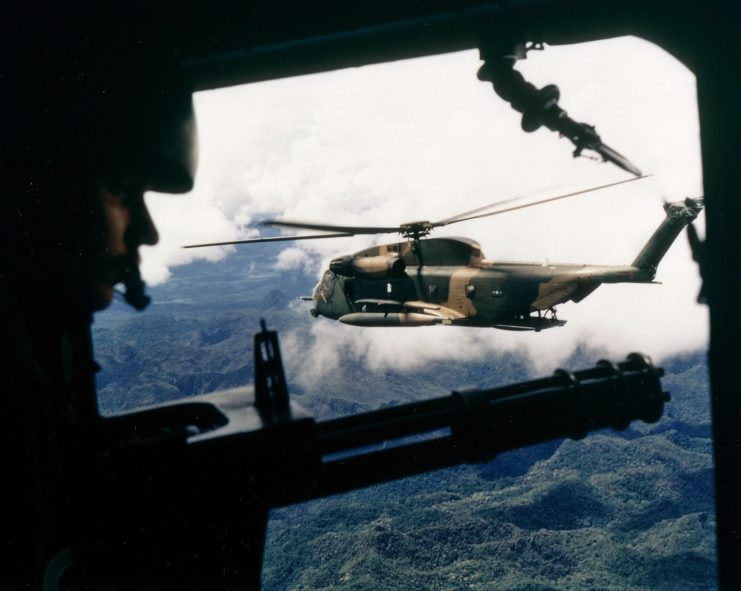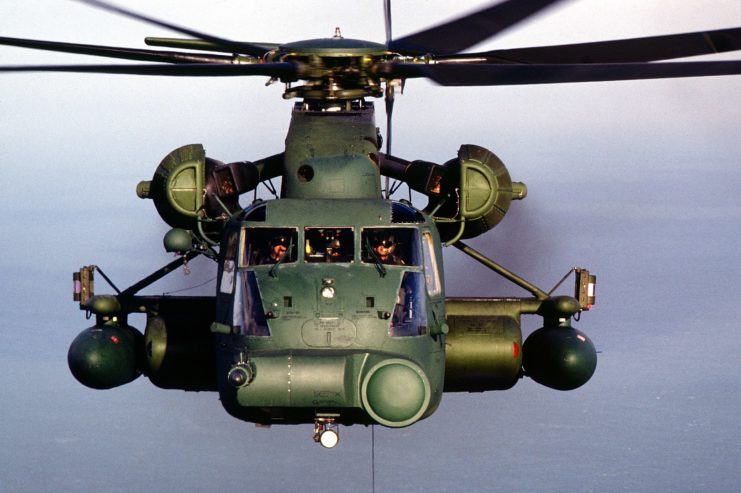Sikorsky MH-53 Pave Lows had the ability to perform both search and rescue and special operations missions. “Pave” stands for “Precision Avionics Vectoring Equipment,” the all-weather sensor system that converted several HH-53s into these advanced helicopters. Their long service life with the US military is proof of their effectiveness, with them having racked up a long list of missions and flight hours.
Early variants of the Sikorsky HH-53

The HH-53 was similar to the Sikorsky CH-53A Sea Stallion flown by the US Marine Corps. Better known as the “Super Jolly Green Giant,” it operated throughout the Vietnam War. The HH-53B variant had a retractable in-flight refueling probe and a rescue hoist located just above the passenger door. It held spindle-shaped jettisonable 650-gallon fuel tanks and was armed with either three GAU/2A 7.62 mm six-barreled miniguns or .50-caliber Browning machine guns.
For protection, the HH-53B was equipped with 1,200 pounds of armor, and it was capable of carrying a five-person crew.
The HH-53C was introduced into service in 1968. Forty-four were built. They were similar to their predecessor, with the most noticeable difference being the removal of the fuel-tank bracing struts. In the earlier variant, it was quickly realized the tanks were affecting the helicopter’s overall performance when full, so smaller 450-gallon tanks took their place.
The HH-53C variant was also equipped with more armor and fitted with a better communications system to improve contact with other craft. In the later stages of the Vietnam War, some were fitted with countermeasures pods to handle heat-seeking missiles.
Introduction of Pave Low III

By 1975, an HH-53B was fitted with the Pave Low II system, changing its designation to YHH-53H. With more adjustments to the system, eight HH-53Cs were then fitted with the system. They were re-designated HH-53H Pave Low IIIs and came with a bunch of upgrades. They became operational on July 1, 1980, and were, at that point, prepared for long-range, low-level missions.
Improvements made by the Pave Low system included forward-looking infrared imagers (FLIRs), as well as terrain-following (TFR) and terrain-avoidance radar. They also packed Doppler-radar navigation and inertial guidance systems (INS), and were equipped with computerized moving-map displays. Radar-warning receivers and chaff-flare dispensers were also added.
In 1986, the CONSTANT GREEN program provided even more improvements to the HH-53H Pave Low IIIs, fitting them with blue-green lighting in their cockpits, making them compatible with night-vision goggles. Following this, they were reclassified as “special operations” helicopters and given the designation MH-53H – “M” standing for “Multi-mission.”
Now, they were upgraded to support both night and adverse weather operations.
Within the Pave Low III program, nine MH-53Hs and 32 HH-53s were converted into MH-53Js. With the upgrades, the MH-53Js became the largest, most powerful and most technologically-advanced helicopters at the US Air Force’s disposal. Their job was to drop-off, pick-up and supply Special Forces behind enemy lines, and were still capable of engaging in search and rescue (CSAR) missions.
Between 1986-90, 31 HH-53Bs, HH-53Cs and CH-53s were upgraded to the new MH-53J configuration. All MH-53Hs were also upgraded, making a total of 41 MH-53Js.
Operation Eagle Claw disaster

In the decades these helicopters served, they participated in numerous missions.
The failed rescue of 52 embassy staff in Iraq during Operation Eagle Claw is what sparked the conversion of the choppers into special operations craft. The Pave Low fleet was assigned to the 20th Special Operations Squadron at Hurlburt Field, Florida. After proving their success, they were assigned to the 21st and 31st Special Operations Squadrons in Europe and East Asia. The 551st Special Operations Squadron at Kirtland Air Force Base, New Mexico also received MH-53Js for training purposes.
MH-53J Pave Lows took part in several critical combat missions for the US Air Force. During Operation Just Cause, the US invasion of Panama, five MH-53Js with the 20th were deployed. They conducted reconnaissance, MEDIVAC, logistics, fire support and small team insertion. Other MH-53Js helped lead the first missions of the Gulf War and War in Iraq.
Several MH-53J Pave Lows were also responsible for evacuating some of the 425 US citizens from the American Embassy located in the war-torn Liberian capital of Monrovia in 1996. Success in this mission proved their implementation to special operations was beneficial and could have greatly benefitted Operation Eagle Claw.
Pave Lows often exercised their CSAR capabilities, despite operating as special operations craft. Some of the fleet successfully rescued two US pilots that had been shot down in Serbia in 1999. They then participated in several dangerous missions in Iraq from 2003 until the end of Pave Low operations.
Retirement of the Sikorsky MH-53 Pave Low

The final mission for the MH-53 Pave Low fleet was on September 27, 2008. The six remaining flew in support of special operations being conducted in Southwest Asia. It wasn’t long after that the rest of the fleet was retired, replaced by the Bell Boeing V-22 Osprey, which remains in service to this day.
More from us: F-16 vs F-18: Key Differences Between the US Air Force’s Most Iconic Fighters
Several MH-53 Pave Low variants stand on-display throughout the US, including at Hurlburt Air Field and Kirkland Air Force Base.
